Resource Center
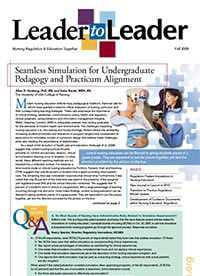
Fall 2009 Leader to Leader
- Allen D. Hanberg and Katie Baraki of the University of Utah College of Nursing outline the Seamless Simulation for Undergraduate Pedagogy and Practicum Alignment model for integrating didactic, clinical, and simulation-based instruction
- Paula B. Saxby of the Virginia Board of Nursing describes three guidance documents designed to help nursing programs comply with board of nursing regulations.
- Learn about the work of the Innovations in Education Regulation Committee
2009 | Magazines

Transition to Practice: Improving Patient Outcomes
This chapter examines the evidence that a standardized transition program for new graduate nurses has a positive impact on patient safety.
2009 | Research Item

Regulation Fosters Innovations in Nursing Education
Because of the complexities in nursing and healthcare delivery and a national focus on patient safety, there has been a call across nursing organizations and healthcare organizations for more innovation in nursing and healthcare education. The National Council of State Boards of Nursing held an invitational roundtable, involving representatives from nursing education organizations, boards of nursing, the American Nurses Association, and the Robert Wood Johnson Foundation. Topics of discussion included the meaning and implications of innovation in nursing education, perceived barriers to innovation, and the future of innovation. This article summarizes the outcomes of the roundtable’s discussion.
2009 | Research Item
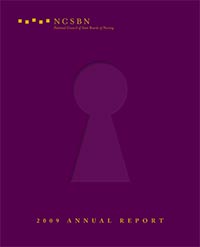
2009 NCSBN Annual Report
This annual report functions as a formal summary of NCSBN’s performance and activities during fiscal year 2009. It also provides financial information, NCLEX pass rates, member achievements and NCSBN facts.
2009 | Publications
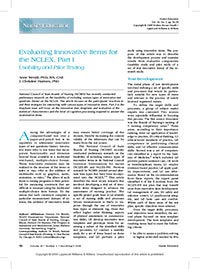
Evaluating Innovative Items for the NCLEX, Part 1: Usability and Pilot Testing
Reprint from Nurse Educator, 34(2), 2009
2009 | Publications
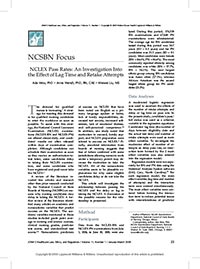
NCLEX Pass Rates: An Investigation Into the Effect of Lag Time and Retake Attempts
Reprint from JONA Healthcare Law, Ethics and Regulation, 11(1), 2009
2009 | Publications
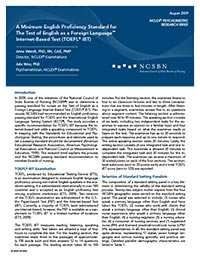
A Minimum English Proficiency Standard for the Test of English as a Foreign Language Internet-Based Test (TOEFL iBT)
A research brief highlighting the National Council of State Boards of Nursing (NCSBN®) 2009’s initiative to determine a passing standard for nurses on the Test of English as a Foreign Language Internet Based Test (TOEFL® iBT).
2009 | Publications
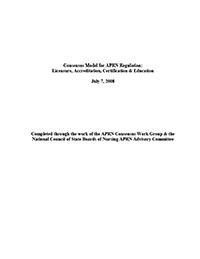
Consensus Model for APRN Regulation: Licensure, Accreditation, Certification and Education
Gain a better understanding of the requirements for adopting the Consensus Model for APRN Regulation.
2008 | Papers
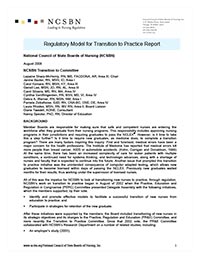
Transition to Practice Report
This report is a companion to the Transition Evidence Grid. The report synthesizes all the evidence on transitioning new nurses to practice. It illustrates the importance of formal transition programs in protecting the public, and it provides the data that support the components of the Transition Regulatory Model. This report was adopted by the May, 2008 NCSBN Board of Directors.
2008 | Papers
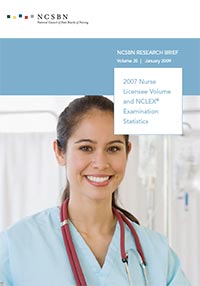
2007 Nurse Licensee Volume and NCLEX Examination Statistics (Vol. 35)
This annual publication provides national and state summary data of Member Boards’ licensure activities, as well as data on candidate performance on the NCLEX-RN and NCLEX-PN examinations. (© 2008)
2008 | Publications
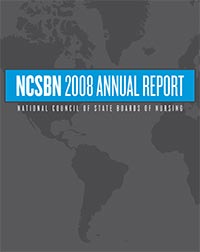
2008 NCSBN Annual Report
This annual report functions as a formal summary of NCSBN’s performance and activities during fiscal year 2008. It also provides financial information, NCLEX pass rates, member achievements and NCSBN facts.
2008 | Publications

Addressing Nonresponse in Surveys
Reprint from CLEAR Exam Review, 19(2), 2008
2008 | Publications
